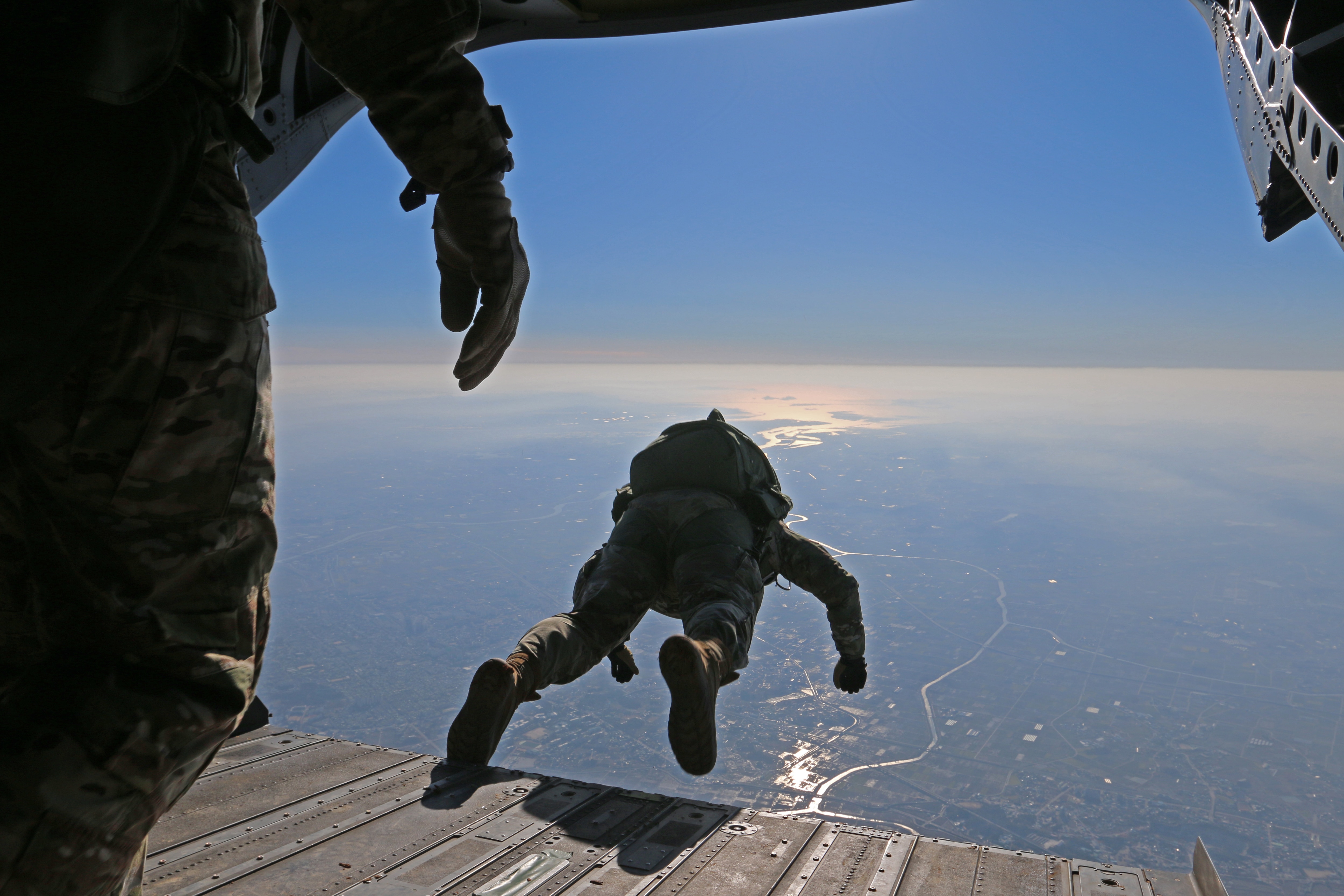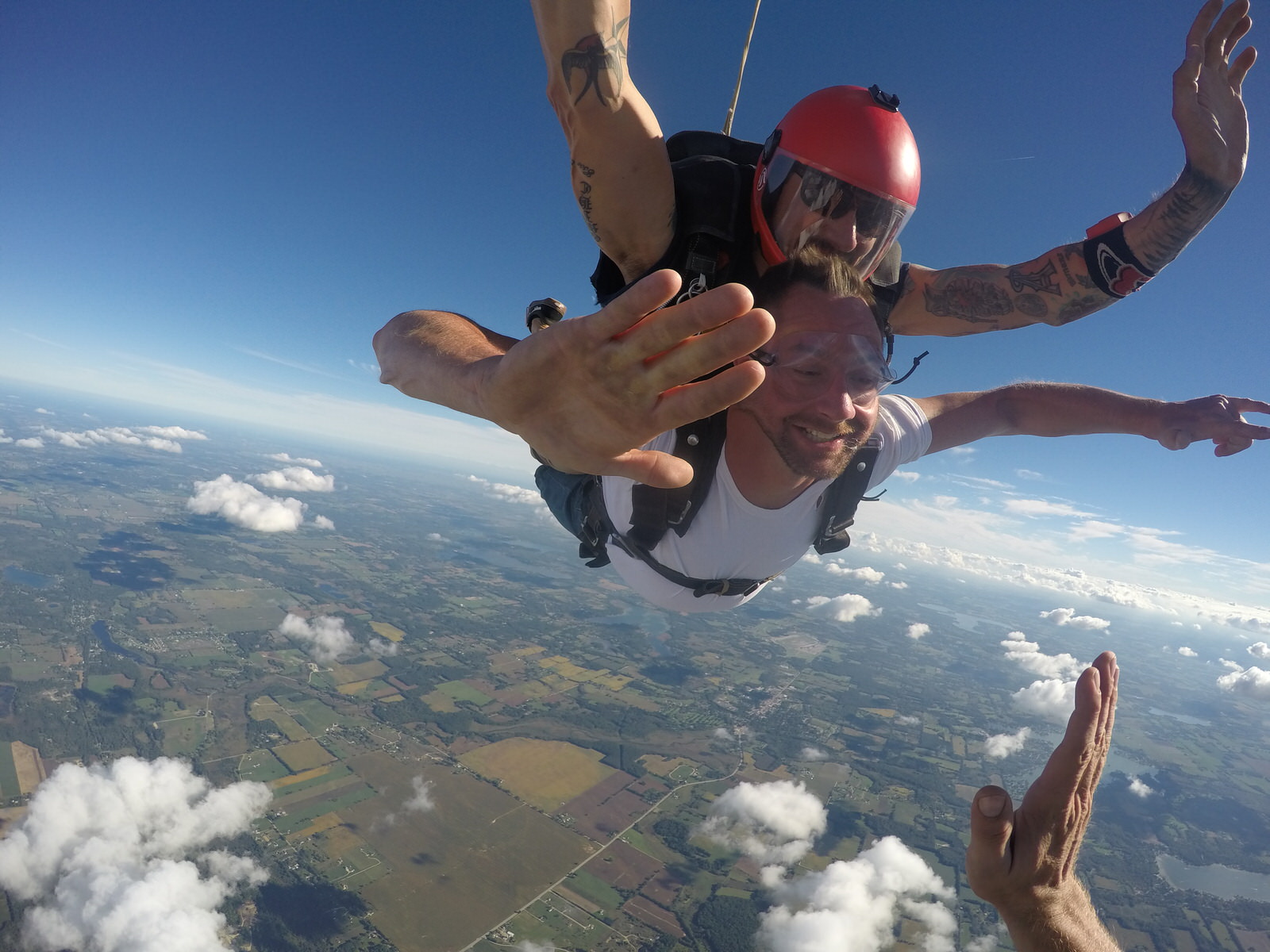Halo Military Jump - HAHO means High Height, High Opening. HAHO jumps are a special type of military parachute jump that occurs when an aircraft cannot fly over enemy skies without posing a threat to the jumper or the aircraft. You jump to great heights, quickly retract and fly under the roof to your destination. Experienced HAHO skydivers can travel 30 miles or more by parachute. Placing the bars up also helps keep the sound of the placed lily from being heard below.
As a traditional skier, the experience will pass quickly, but HAHO air jumps can last up to 20 minutes. The roads open so fast that you will avoid the experience of flying on Earth at 200 miles per hour and will come close to the indescribable feeling of floating in the air as you soak in the amazing scenery around you.
Halo Military Jump

The total time under the roof varies, but you can spend 20 minutes or more in the air. Actual time is based on your comfort level and air conditions.
A U.s. Air Force Pararescueman During Halo Jump Training In Afghanistan, 2018. [5179 X 3499]
There was very little free fall on the HAHO jump because the rocket ignited 10 to 15 seconds after leaving the jump plane.
We use aircraft capable of carrying jumpers to an altitude of 28,000 feet. By comparison, the normal altitude for a traditional jump is about 13,000 feet. At an altitude of 28,000 feet, supplemental oxygen is needed and the outside air temperature can easily drop below 30. (Actual jump altitude is based on FAA approval and weather conditions.)
All HAHO jumpers must be at least 18 years of age and in good health. Haha Tandem Jumpers must weigh less than 240 pounds and have not had surgery in the past 18 months or donated blood in the past 30 days. If you have any specific health questions or physical needs, please contact Incredible Adventures.
Ideally, you should have three days for your application. This allows you to work out one day, dance the next, and weather it back. Sometimes it is possible to train and dance on the same day.
The Army Wants A New Special Operations Parachute For Higher Jumps
You can arrange to hire a videographer to follow you in the sky and record your jumps, or you can choose to record your video using the handheld camera.
We provide each jumper with a Gentex HGU 55/P ballistic helmet, the same lightweight helmet worn by US Air Force F-15 and F-16 pilots to provide protection during High G mission and oxygen barrier military-grade Gentex MBU 12. Civilized racers are also equipped with strategic goggles, Airox VIII O2 regulator, Twin 53 or Twin 22 auxiliary bottle caps, flight kits, gloves and altimeter.
The best months to dance are from April to October. Due to the cold air temperature at high altitudes and the HAHO jumper being in the air for a long time, we recommend that you schedule the HAHO jump during the hotter months.

No, skydiving is really dangerous. You can die. You will be required to sign a release of liability assuming all risks and agreeing that there is no insurance. That said, you will be jumping with an experienced master whose main goal is to keep you on safe ground. He will use some of the best tools available and take all possible steps to make your haho jumping adventure as safe as possible.
Sof Pic Of The Day: Italian Army Special Forces Haho/halo Jump
Prices start at $4,500 per person and include dance training, shared dances, use of self-portrait video equipment, photos and a certificate of completion. With a videographer, the price is set at $5,000. Hotel accommodation, meals and travel to the dance venue are not included. This article or section needs sources or references that appear in reliable third-party publications. Please help improve this article or section by expanding it. (August 2011) (Find out how and how to delete this sample message)
Military high-altitude parachuting (MFF) is a method of securing military personnel, military equipment and other military supplies from high-altitude transport aircraft through the free deployment of parachutes. Two techniques are used: HALO (High Altitude Jump, often called HALO Jump) and HAHO (High Altitude Jump).
In the HALO technique, the skydiver jumps to a low altitude after a free fall, while in the HAHO technique, the skydiver jumps to a high altitude just seconds after jumping from the aircraft.
Although the HALO technique was first developed in the 1960s for military use, in the same year the HALO parachute design was widely used in non-military applications, including skydiving.
Juggernaut.navboard On Behance
In military operations, HALO is also used to secure equipment, supplies, or personnel, while HAHO is commonly used for personnel. In typical HALO/HAHO deployments, soldiers jump from altitudes between 15,000 and 35,000 feet (4,600 and 10,700 meters).
Military paratroopers often reach a stall speed of 126 miles per hour (203 km/h), allowing a jump time of less than two minutes.
The origins of the HALO technique date back to the 1960s, when the US Air Force began conducting experiments following earlier work by Colonel John Stapp in the late 1940s.

Until the early 1950s for survival for pilots who fell at high altitudes. Stapp, a biophysicist and physician, used himself in rocket tests to study the effects of high g-power. Stapp also tackled many of the problems of high-altitude flight in his first job with the United States Air Force and set himself to touch altitudes of up to 45,000 feet (14,000 meters). He later helped develop pressure vessels and ejection seats, which have been used on airplanes ever since. As part of the experiment, on August 16, 1960, Colonel Joseph Kittinger made the first high jump of 19.5 miles (31.4 km) above the Earth's surface. Kittinger's Frid Jumper and United States Marine Test Jumper Joe Crotwell was also among the original program's consultants and test jumpers. The first time this technique was used in combat was during the Vietnam War in Laos by members of MACV-SOG Recon Team Florida. The US Navy SEALs have expanded the HALO technology to include the transportation of boats and other large items.
Halo Jump By Brezzzzzz On Deviantart
This technique is used to drop supplies of equipment or personnel at high altitudes where aircraft can fly above surface-to-air (SAM) levels through EMI skies without threatening transport or cargo. In the event of an active anti-aircraft cannon near the drop zone, the HALO technique also reduces the influence of the paratrooper's reference to the flames.
For military cargo aircraft, the heavy cargo is cut loose and removed from the aircraft by gravity. The load continues to drop under the roof in the designated drop zone.
In a typical HALO exercise, the paratrooper will jump from the aircraft and free fall for a period of time at terminal velocity, and his parachute jumps at altitudes as low as 3,000 feet (910 meters) AGL depending on the mission. The combination of high downhill speed, low headwind speed and minimal metal wear helps eliminate radar and reduces the time that parachute jumps can be seen by ground observers including stealth.
The HAHO technique is used to drop personnel at altitudes where the aircraft cannot fly above Amy's sky without endangering the jumper. In addition, the HAHO parachute jump is used in the covert infiltration of military personnel (special operations forces in general) into enemy territory in circumstances where the covert nature of an operation can be facilitated by the loud sound of the parachute. Jump to low heights.
High Altitude Military Parachuting
HAHO jumps also allow for longer travel distances due to the increased time under the roof, which allows for more than 40 miles (64 km).
In a typical HAHO exercise, the jumper will jump from the aircraft and deploy a parachute immediately after landing. The jumper will use a compass or GPS device for guidance when flying 30 miles or more (50 km). Jumpers must use waypoints and terrain to navigate to the desired landing zone and adjust their course to account for wind speed and direction changes. If deployed as a team, the team will form a stack while flying with their parachute. Normally, the jumper in the lowest position will set the course and act as a guide for the other team members. The HAHO script (except for training) is set to run at night.
While in the British Special Forces (22 SAS) with a background in mass parachuting, Charles "Nish" Bruce was a key figure in the initial testing and development of the now HAHO strategy. It is routinely used to enter conflicts for special forces.

In the United States, military personnel who wish to participate in military operations at high altitude must undergo rigorous training with strict laws and regulations. Military freefall is the most dangerous and physically demanding skill in special operations. MFF operations are usually conducted under the cover of darkness to hide the operator's prefix from opposing forces.
File:calfex Begins With Philippine Halo Jumps 140515 M Mn153 010.jpg
The transition to free military certification began with the successful completion of static line certification at Fort Bragg,
Halo jump, halo portable jump starter, halo battery jump starter, halo jump starter, military halo, military jump boots, halo flashlight jump starter, halo jump pack, halo bolt jump start, military jump, halo bolt jump starter, military halo jump
0 Comments